How To Make an App Like Spotify
Music streaming applications have taken center stage in the entertainment industry. Spotify has emerged as the market leader here, providing users with a sleek interface and an extensive song library. Spotify is leading the music revolution with over 180 million subscribers globally and over $10 billion in profits. Its success entices entrepreneurs and businesses to tap this industry and build an app like Spotify. Several factors come into play if you want to create a music streaming app like Spotify. Understanding the dynamics and complexity of Spotify development can be a great place to start this journey.
In this blog, we will cover many factors like the feasibility of the idea and the model, the key features of the app, and the development process of building an app like Spotify.
Let’s dive in!
Is Creating a Music Streaming App a Good Investment?
The music industry has incredible potential and is rapidly expanding. Market statistics indicate that global music subscribers have surged to 523.9 million over the past few years. On average, an American music listener listens to songs for 75 minutes daily. This industry has a CAGR of 9.8% from 2021 to 2027.
Another solid reason to invest in an app like Spotify is that it offers many opportunities. 5G streaming, AR, VR, and other tools are increasingly incorporated into music apps to enhance user experience. The streaming model of music distribution is the most convenient model for users because it is easy to use and very interactive. Music apps are now officially more profitable than selling music tracks on physical media!
Hence, investing in creating a music streaming application is a great way to capture this potential. It gives users a value proposition that is hard to deny.
To better understand this, let’s first understand Spotify’s business model.
The Business Model of Spotify
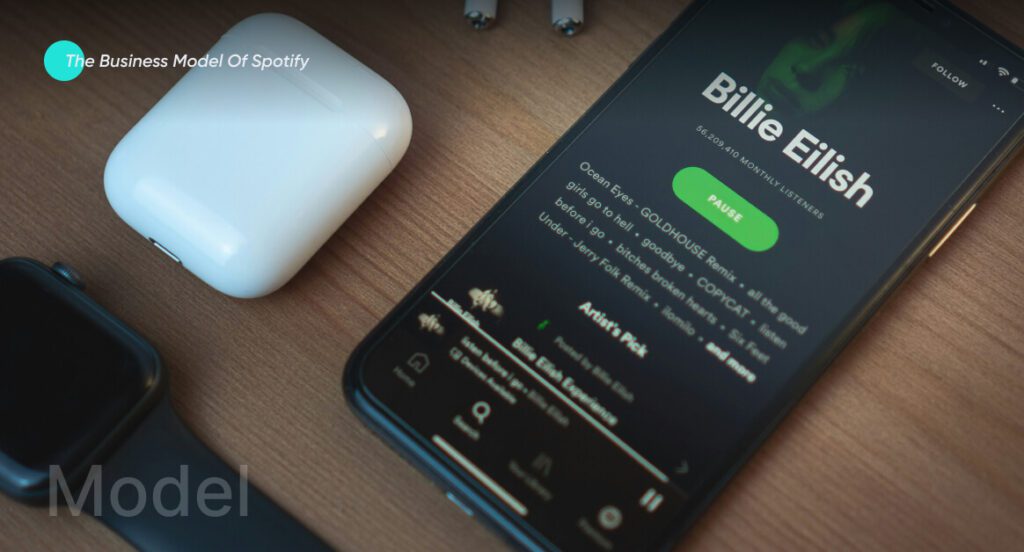
Spotify was created in 2006 to respond to the exponentially growing piracy problem in the music industry. Due to its legally and ethically sound business idea, the app has become a widely used audio streaming medium.
Spotify has a freemium business model that offers a basic , ad-supported, and limited version of the app for free. It also provides an unlimited premium version that has a subscription fee. This version is ad-free and offers unlimited access to all app functions.
Spotify has a legal framework to ensure content creators are compensated well for their intellectual property. Since 2006, Spotify has paid more than $10 billion in royalties to music labels, reinforcing morally sound business practices.
Features of An App Like Spotify
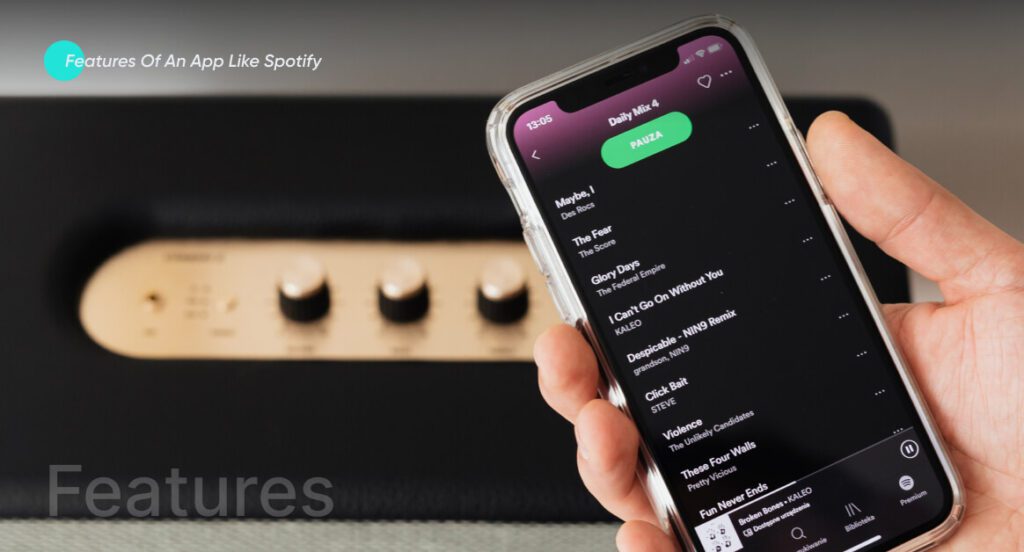
A consumer-centric app like Spotify offers several features that enable hassle-free listening. If you want to create a music app like Spotify, here are some features you must incorporate:

Sign-up/Sign-in
Starting to use a music streaming service should always be smooth and hassle-free. Users should be able to register on the app free of charge and personalize their profiles to their liking. Given the increased emphasis on app integration, ensure that users can link their social media profiles to your app and search for their friends and followers.
User Profile
The user profile provides information about the user: username, email address, profile picture, nickname, mobile number, password, and bank account details. It is an essential feature that helps apps keep track of their user and vice versa.


Audio streaming
Spotify is inherently an audio streaming application. It lets users listen to high-quality audio content online without downloading the files. It saves storage on the user’s device and provides them with real-time audio content. The feature breaks the audio file into small chunks and sends them to the user’s device over the internet. As the user listens on time, subsequent chunks are sent to the user’s device via the internet.
Music Library
Spotify is a one-stop solution for all audio entertainment needs, offering an extensive library of over 100 million tracks, albums, playlists, and podcasts. It also boasts a vast collection of music tracks catering to its users’ diverse tastes. Spotify provides an unparalleled listening experience that keeps users entertained for hours.


Playlists
Playlists make Spotify what it is: a ground-breaking music streaming sensation! They allow users access to curated playlists they can manage and enjoy playback of their chosen audio tracks. Use algorithms oriented at helping users discover new music that aligns with their preferences. Moreover, adding an option that allows users to create personalized playlists within the music app adds more value to your application.
Podcast and Audiobooks
Spotify offers many spoken-word content, including podcasts, audiobooks, and other audiovisual content. Spotify is home to over 5 million podcasts, over 350,000 audiobooks, and over 100 million audio tracks. Users with Spotify Premium have access to over 150,000 audiobooks and 15 hours of listening a month. Moreover, Spotify for Podcasters is a popular tool users use to create, share, and distribute podcasts.


Concerts and Events
Spotify’s Live Events Feed offers personalized show recommendations based on user taste profiles. Ticketing partners like Ticketmaster, AXS, DICE, Eventbrite, and See Tickets are included.
Search
The Spotify library has millions of audio files. Spotify allows users to find and discover music through the search feature to ensure easy access to all these files. To create an app like Spotify, you must incorporate the search feature to improve user accessibility. Users can access songs, artists, albums, playlists, and podcasts. Moreover, the search feature is excellent for helping users filter results according to their preferences: release date, popularity, genre, and popularity.


Social Features
Users can follow friends, artists, and influencers on Spotify to discover new music and share recommendations. This adds a social factor to the application and facilitates music sharing.
Push notifications
Spotify, like other applications, also facilitates users with push notifications. They are a great way of informing users about new releases, upcoming events, and concerts and providing personalized recommendations based on their listening history. It’s a great way to ensure that all users are updated on the newest content by their favorite artists and that they can discover new tracks and artists. They also update users about account activity, updates, and other information relevant to payment dates, subscription details, etc.


Download
On Spotify, users with premium subscriptions can download songs, albums, playlists, and podcasts to their devices. This allows users to listen to music on the go without connecting to the internet.
Additional Considerations for Creating an App Like Spotify
Succeeding with your streaming app isn’t easy in today’s competitive music industry. To stand out and provide users with additional value proposition, you can incorporate these additional features into your music streaming app:
Backend Infrastructure & App Database
The backend infrastructure of your application needs to be robust and should be able to adeptly manage metadata, reviews, user profiles, and listening history. Moreover, organizing all this information is as important as a sound database. Your backend must also be scalable to accommodate any surge in the number of users.
Localization and Globalization
If you want to build a music streaming app like Spotify and make it a universal success, your app must have a global appeal. It should include all cultures and shatter regional barriers. Moreover, localized music on your app should celebrate the beauty of diverse cultural niches rather than uphold linguistic barriers.
Cross Platform Accessibility
This strategy involves using a single code base to cater to multiple operating systems, along with pre-existing libraries and components. Adopting this approach can lead to cost savings, as businesses only need to invest in one codebase instead of separate ones for each platform. However, ensuring a consistent user experience across various devices and operating system versions may prolong the development timeline.
Security
Platforms like Spotify have sensitive information like user passwords, payment details, personal tastes, and preferences. Hence, a robust security system must be implemented to ensure that all user information is safe.
Collaborative Playlist
Users can collaborate with others to co-create playlists, enhancing the social and interactive aspects of listening to music.
Story
Spotify introduced ‘Storyline,’ a feature that allows artists to offer inspiration, tales, or insights behind their songs, strengthening their relationship with listeners and taking cues from social media trends.
Integration With Other Platforms
Spotify provides hands-free music control by integrating easily with smart speakers such as Google Home and Amazon Echo. Users can control playing or even store music offline on their wearables if their device is compatible with Apple Watch or Garmin. Moreover, Spotify also has relationships with other apps. For example, it has integrated with Waze to enable seamless navigation while listening to your favorite music.
Artist Profiles and Analytics
Your app needs to provide some value proposition to artists to provide users with good-quality content. Hence, it provides artists with features that help them track their music performance and user persona and an easy uploading experience.
See our latest relevant exploration Unlocking Live Streaming App Development
![]()
Process of Building an App Like Spotify
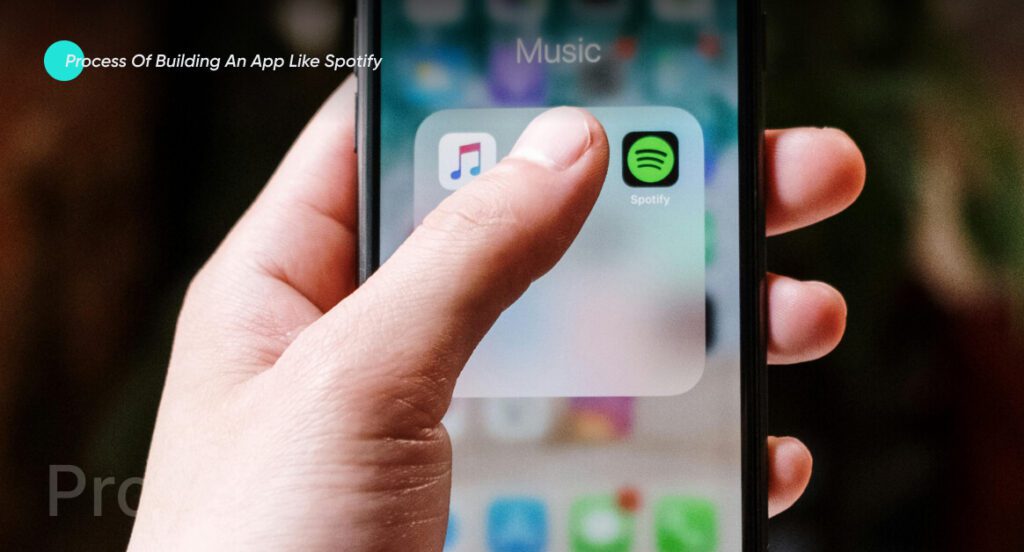
Step 1 – Market Research
Market research gives you an eagle’s eye view of the target market. It highlights all the factors you must consider to launch a successful application. You can better understand what the consumer needs and what makes your app stand out in this competitive market. It’s always better to consult with experts for more thorough market research. They have the expertise to maximize your revenue.
Step 2 – Consider the main Spotify-like app features
A music streaming app like Spotify should have features like registration and sign-in, music exploration, social sharing, push notifications, playlists, etc. We have discussed these in detail here.
Step 3 – Choose the licensing type.
A license ensures the legal existence of your application. If you want to create a music streaming app, your platform should have these licenses:
- Sound Recording License Agreement
- Musical Composition License Agreement
- Public Performance Rights by BMI or ASCAP
- License from European Stage Authors and Composers
Depending on your geographic market, additional licenses may be required based on local laws and regulations. Consult with local lawyers specializing in licensing for better insight into this matter.
Step 3 – Design, User Experience (UX), and Prototyping (MVP)
Your music streaming app should have a user-friendly interface with strategic fonts, visuals, color palettes, and other factors to engage users and boost engagement. Remember, a smooth UX is about logical content arrangement, quick response rate, and logical content arrangement.
Design a minimum viable product (MVP) to get a rough idea of what the app will look like with your current requirements. Here, you need a Wireframe, Mockup, and Prototype. The app can move into the final development stage if the prototype aligns with your expectations and strategic goals.
Step 4 – App Development
Choose your music streaming app development very carefully. Having good developers onboard can make a world of difference in the development process. Stay updated on their progress and point out things you disagree with; this helps ensure you are on the same page.
Step 5 – QA Testing
Invest in QA testing to ensure that all bugs and flaws are removed from your application before being used by a broader user base. Performance evaluations, usability checks, and security assessments ensure your app’s long-term success. Moreover, post-launch updates like user feedback and listening experiences should be incorporated for continuous improvement.
Step 5 – Deployment and Launch
Once the QA team approves your app, the deployment stage will follow. Prepare your music-streaming app for distribution and packaging, then set up servers and configure settings. After navigating the deployment stage, launch the app to the broader public.
Step 6 – Support and Maintenance
Your app needs support and maintenance to stand the test of time. Ensure all user feedback is considered and they are provided support where needed.
Monetization of an App Like Spotify
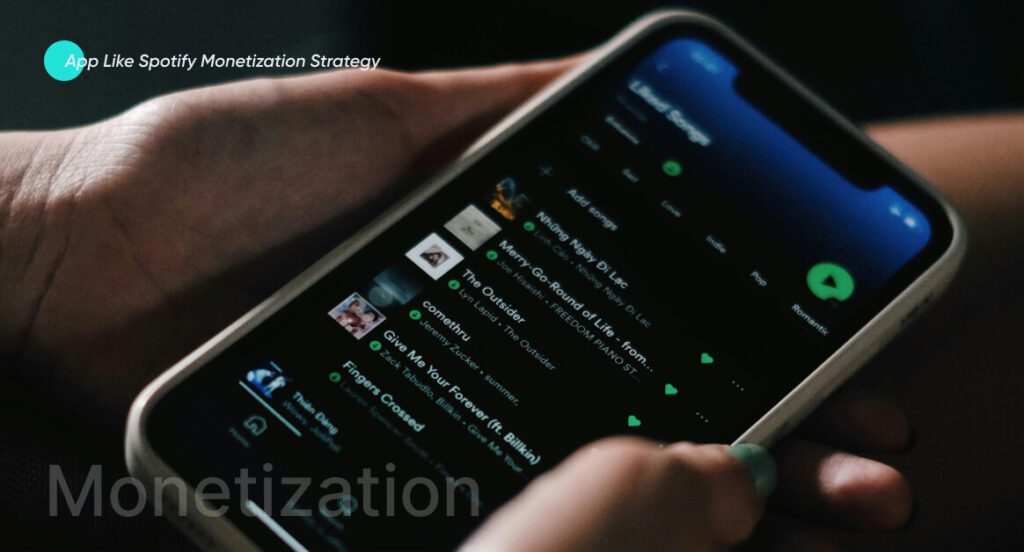
Your app idea must have a revenue potential to survive in the cutthroat market today. If you want to make money from your music-streaming app, you need to define a proper revenue stream with the business model and justify it compared to app operations. Once you can cover the operational cost, you can hop onto the next step and maximize ROI.
We’ve discussed Spotify’s business model in the first section of the blog; as an entrepreneur looking into creating another app like Spotify, you can refer to their business model. Here are some of the most popular monetization strategies that you can use for your app:
In-App Ads
In-app advertising is a popular way to monetize apps. Through the application, owners sell their space to advertisers to reach their target audience. Ads are displayed in interactive ways to engage users. Popular in-app advertisements include banner, video, text, and native ads.
Subscriptions
Subscription models are a popular way to monetize apps. Users pay weekly, monthly, or annually to access specific content or services. Examples include Spotify, Netflix, Google, and Amazon Prime.
Sponsorships
Mobile apps can earn money through sponsorship deals with brands in the same market niche. Two deals can be made: revenue sharing or a fixed monthly fee the sponsor pays the app owner.
Freemium Models
In-app purchases are a popular way to monetize apps. Users can download apps for free but must purchase virtual goods and services within the application. There are two categories of in-app purchases: consumables and non-consumables. It’s a great revenue model for apps that maximizes user interaction.
While these monetization strategies suit your business, you must choose one that aligns with your strategic goals.
See our latest relevant exploration How do you Choose an Effective App Monetization Strategy? ![]()
Development Cost of An App Like Spotify
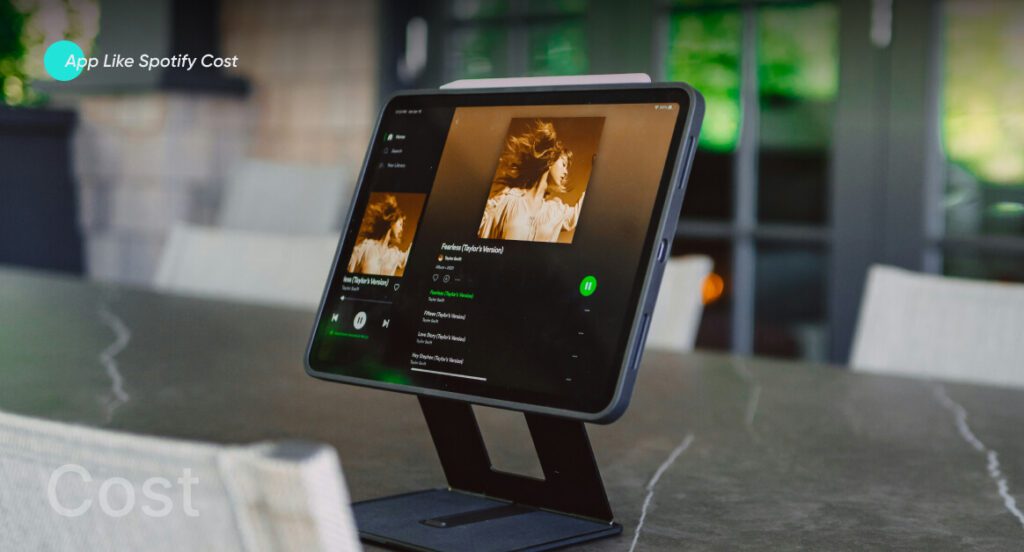
The cost of developing an app like Spotify depends on the complexity of the features you incorporate. Moreover, the time frame required to create a functional app also contributes to the overall cost of the application.
This is the approximate cost of developing an app like Spotify:
| App Type | Approximate Cost | Time Frame Needed |
| Simple App | $40500 to $54000 | 4 to 6 months |
| Moderately Complex App | $63000 to $90000 | 7 to 9 months |
| Highly Complex App | $90000 to $225000 | 10+ months |
How can Coding Pixel help you create a music streaming app?
Building a music streaming service like Spotify requires significant time, money, expertise, and resources. Doing so without the expertise of an app development company can put you at risk of potential losses. At Coding Pixel, our experts have over eight years of experience and hundreds of successful app projects. Our developers know how to strike the right balance between adaptability and stability.
Talk to our team if you’d like to build an app like Spotify!. See our Music Streaming App Development Service ![]()
FAQ
Developing a music streaming app can cost anywhere from $54,000 for a basic version to $225,000 or more for a feature-rich or multi-platform solution. The cost depends on app complexity, development team location, platform, and features.
Spotify’s revenue comes from two sources – subscription-based model and advertisements.
Competing with music streaming giants like Spotify isn’t easy. However, you can start with unique content offerings or exclusive releases and collaborations with artists for exclusive sessions or interviews. Moreover, gamification elements can increase user engagement. Offer introductory offers or discount
Masifa is a Content Specialist with a bachelor’s degree in marketing and over three years of experience in content marketing and the IT industry. She is passionate about writing and talking about website and mobile app development, e-commerce, and advancements happening in the IT Industry. She creates engaging and user-centric content to optimize digital experiences for these niches. When she is not creating content, you can find her buried in a good book.